More about Thimbles





Magdalena and William Isbister.
Introduction
There are very few accounts of thimbles from Eastern Europe (excluding Russia) in the thimble literature. Herand porcelain thimbles from Hungary are mentioned by both von Hoelle and Holmes (1, 2) but thimbles from no other Eastern European countries seem to deserve even a mention. Could this be because with the exception of the Herend factory no other former communist country produced thimbles? This explanation seems a little improbable. More likely seems the notion that information regarding these countries in general and thimbles in particular during the communist period did not come across the ‘iron curtain’ very freely, and this was the time when thimble writers were most prolific in their writings.
This paper is written in the hope that other collectors with thimbles from Eastern Europe will come forward in order that we may create an archive of such thimbles for future collectors. The authors hope that those collectors with such thimbles will contact them.
We have personally come across relatively few thimbles from Eastern European countries and we have not seen or heard of any ‘old’ thimbles, although clearly thimbles must have been in use in these countries for hundreds of years. The thimbles that follow were probably all made in the 20th century. We have only been able to find thimbles from Bulgaria, Czechoslovakia, Estonia, Hungary, Latvia and Poland
Bulgaria
We discovered a single porcelain factory in Bulgaria which produced thimbles for the Thimble Collectors Club, Chessington, United Kingdom.
Kitka
This company was established in the town of Novi Pazar in 1919 as a roof tile and brick works. It gradually expanded until it was producing fine porcelain and glassware. It is not known when thimble (fig 1, 2) production commenced.


Fig 1 Fig 2
Czechoslovakia
Bohemia (the German word for Czech) is famous, not only for its glass works, but also for the many potteries which have been making fine pottery for over a century. During World War II many potteries were taken over by the Nazis and many companies had to change their marks to include Nazi symbols. After the war the potteries were nationalized under communism but now most of them work independently again. It is not known which of the many potteries made thimbles and it is not known when thimble production commenced in a particular pottery. It is possible from the marks inside of the following thimbles to identify the maker (3).
Cesky Porcelán Dubí
Founded in 1864 and still in operation today. It is famous for its ‘blue onion’ pattern porcelain. The blue onion pattern has its origins in the faulty interpretation of one motif of the pattern, the depiction of a pomegranate, which may resemble an onion. The style originated in China, was copied by Meissen and is executed under the glaze. The technique is generally limited to the very stable cobalt blue paint which is able to withstand the high kiln temperatures and is often known as ‘blue under glaze’. This technique is in marked contrast to the usual method of painting, which is called ‘over glaze’ as the paint is applied after the porcelain has been fired and glazed. A modern (1945-59) example of a blue onion under glaze from the Dubí factory and the maker’s mark are shown in figures 3 & 4.
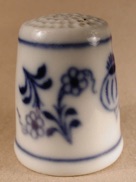
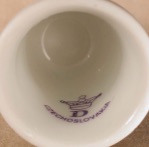
Fig 3 Fig 4
Karlovarsky Porcelán
The next thimble (fig 5) has a different mark to the thimble shown in figure 3 but was probably made by a related factory – possibly Karlovarsky Porcelain. It depicts a double serrated leaf with a flower located above it. This represents a peony bush, which symbolizes wealth, stateliness and growth. The maker’s mark (fig 6) is not very clear but has above and below the symbol ‘Made in Czechoslovakia’ and ‘Zwiebelmuster’. It probably dates to around the same time as the previous thimble.
Karlovarsky Porcelán originated from the Österreichische Porzellan Industrie AG (OEPIAG), which was an association of porcelain factories formed in 1918 by the Austrian government. In 1920 the name was changed to Erste Böhemische Porzellan Industrie AG (EPIAG) OEPIAG/EPIAG was not a factory in its own right since each factory was maintained as an independent business. In 1945, the EPIAG companies were merged into Starorolsky Porcelán and in 1958, Starorolsky Porcelán merged into Karlovarsky Porcelán. At one stage Karlovarsky Porcelán was one of the owners of what later became Cesky Porcelán Dubí.
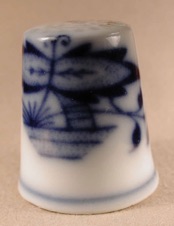
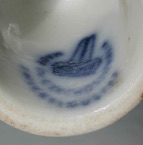
Fig 5 Fig 6
Haas & Czjzek, Chodau
This factory was founded in 1811 by Franz Miessl in Dolní Chodov (Chodau in German). The works had several owners before Haas & Czjzek purchased the factory in 1872 and named it Haas & Czjzek branch Chodau. Following the Second World War the factory was nationalized into Karlovarsky Porcelán. The factory is still in operation today as a branch of Thun Karlovarsky Porcelán. The thimble in figure 7 is hand and transfer printed and shows an agricultural scene. It is made of pink clay and hence the mark ‘ORIGINAL ROSA PORZELLAN’ (fig 8). It was made in the 90s.
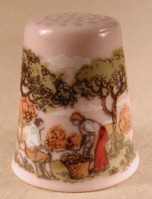
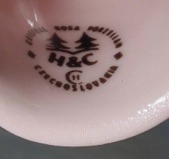
Fig 7 Fig 8
Haas & Czjzek, Horní Slavkov
Founded in 1792 it was the first operational Porcelain factory in Bohemia. Slavkovsky is the Bohemian name of the forest and mountains surrounding the area where the factory was built. After the Second World War it was nationalized into Karlovarsky Porcelán. In 1992 the Horní Slavkov works became independent again and is still in operation today as Haas & Czjzek, Horní Slavkov. The factory uses an ‘’S’’ (fig 10) in the mark to differentiate it from the other Haas & Czjzek works in Chodau, which used a ‘’C’’ (fig 8). The thimbles in figures 9 and 11 were made in the 90s.
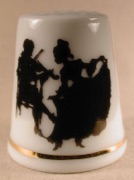
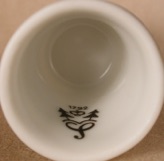
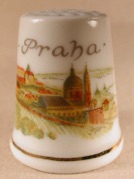
Fig 9 Fig 10 Fig 11
The blue Bohemian glass thimble (fig 12) was probably made in the early 20th century and is heavily gilded. The maker is unknown.
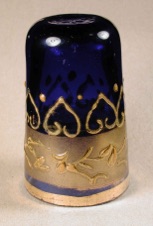
Fig 12
Undoubtedly many more of the Czechoslovakian porcelain factories have produced thimbles over the years. As a consequence of multiple ownership, the Second World War, communism and finally independence many of the works have interrelated ownership and it is extremely difficult now to discover who may have made what in the past. A large number of modern Czechoslovakian ‘instant thimbles’ (4,5) were sold through the Thimble Collectors Club and bear the marks of such works as Bernadotte, Bohemia, Pirkenhammer, Royal Dux, Royal Mosa and Slavkov.
A post World War II etui comprising a thimble, needle case and thread winder has been identified by a friend (fig 13, 14).
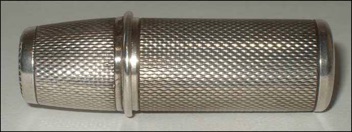
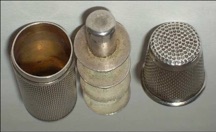
Fig 13 Fig 14
The mark on the base of the etui dates the etui to some time after 1929 (fig 15), but the marks on the thimble and thread winder date the thimble to after 1949 for .835 silver (fig 16).
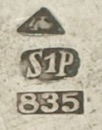
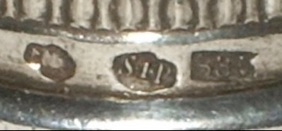
Fig 15 Fig 16
The thimble and etui case have a simple machined finish with no other form of decoration. We have not been able to discover many other Czechoslovakian thimbles, and no other metal ones, and little seems to be known about their history.
Estonia
We have been able to identify a single silver finger guard (fig 17) which has been attributed to Johan Heinrich Schubert in the German journal ‘Rund um den Fingerhut’ (6). Schubert lived in the northern Estonian town of Rakvere and the thimble was made in the middle of the 19th century.
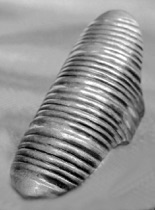

Fig 17
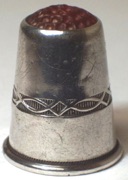
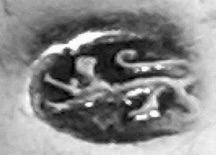
Fig 18 Fig 19
A silver thimble (Fig 18) with a stone top and inside gilding and probably made in Finland, has 800 stamped inside the top and the Estonian quality mark (Fig 19) stamped on the side,
Hungary
We have not been able to identify any non-porcelain Hungarian thimbles. Groiss (7), however, in his book about the Settmacher works in Vienna, does mention Weiss in Budapest who was ‘dealing with the manufacturing and marketing thimbles’ but we have been unable to discover anything further about this company. As in Czechoslovakia there are many porcelain factories in Hungary but it is not known which ones produced thimbles with the exception of Herend and Hollohaza.
Herend
Situated in the Bakony Mountains near Budapest, it has been in operation since 1826 where Vince Stingl with a few other workers commenced the production of porcelain goods, It is claimed that it is now the ‘world's largest porcelain manufactory’.
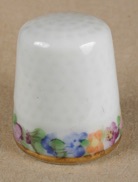
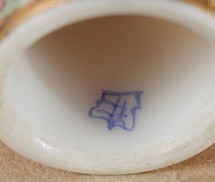
Fig 20 Fig 21
A 19th century simple white porcelain glazed thimble (fig 20) with a hand painted floral border above a gilded rim is marked inside the rim (fig 21). The mark dates the thimble to around 1850-60.
Two modern Herend thimbles from the 1980’s and their marks are shown in Figs 22-25.
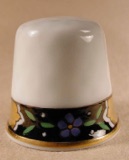
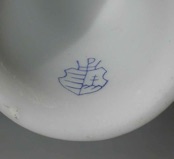
Fig 22 Fig 23
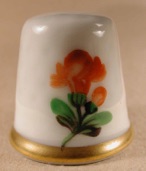
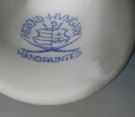
Fig 24 Fig 25
Hollohaza
Hollohaza is situated in northern Hungary and was the site of several pottery and ceramic works. Production commenced in 1772 but it was not until 1950 when pottery and ceramic production ceased that fine porcelain was manufactured. It thus seems unlikely that thimbles were made before 1950 in Hollohaza and now the works seems to produce transfer printed, inexpensive ‘instant thimbles’ (figs 24, 25).
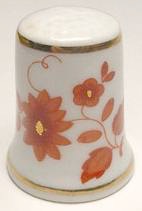
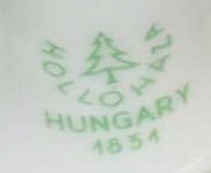
Fig 26 Fig 27
Our last three Hungarian thimbles from the 1990s are by unknown makers. The hand painted flower on the plain white porcelain thimble in figure 28 is signed ‘EC’ but there are no marks on the thimbles shown in figs 29 & 30. Note poor glazing with multiple cracks (coarse crazing).
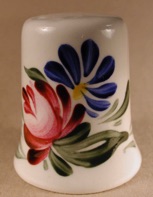
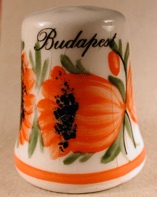
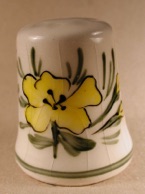
Fig 28 Fig 29 Fig 30
Latvia
One of the oldest East European thimbles that we have found comes from Latvia (fig 31, 32). It depicts a harbour scene with a boat carrying the name ‘Riga’ (fig 33). It is marked with a maker’s mark (unknown), town marks (unknown) and a face facing left. It has a ‘backed’ steel top.
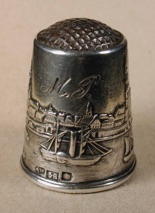
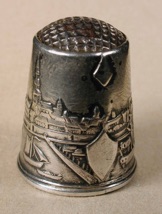
Fig 31 Fig 32
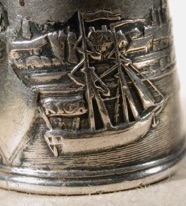
Fig 33
The other two Latvian thimbles are also silver and have ‘backed’ steel tops (figs 34, 36). The thimbles were made in the early 20th century. The makers mark ‘WL’ and the silver fineness mark - a female face facing left and 875 - can be clearly seen (fig 35).
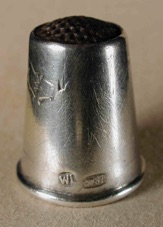
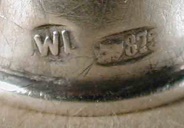
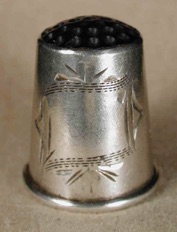
Fig 34 Fig 35 Fig 36
We have been unable to identify any other Latvian thimbles.
Poland
We have been unable to find any old Polish thimbles although we feel that they must exist somewhere? Groiss (7) does mention the company Fabrijka napartskow in Poland who were ‘dealing with the manufacturing and marketing thimbles’ but we have been unable to discover anything further about this company. Contemporary thimbles may be made of wood, amber, silver with amber tops and ceramic. The Poles as well as the Russians made Babuzka dolls and, of course, there are Babuzka thimbles made of Polish birch from Tarnow (fig 37).
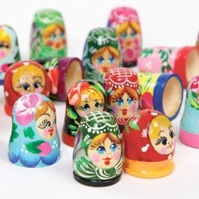
Fig 37
Amber is a fossilized resin and is frequently to be seen in Polish jewellery. Thimbles turned from an amber block are made in Poland (fig 38). Amber is often used to top ‘keepsake’ silver thimbles but clearly these thimbles would not be good for sewing because of the soft nature of the amber itself. Two modern amber thimbles, made in the 1990s and bearing an unknown makers mark ‘MC’ also bear the Warsaw town mark ‘W’ and the silver fineness 925. They are cast silver (fig 39, 40). It seems possible that similar, amber decorated, thimbles were made for the tourist trade in other Eastern European countries around the same time.
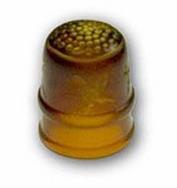
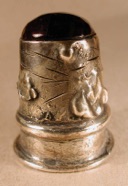
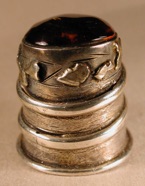
Fig 38 Fig 39 Fig 40
Ceramic potteries have been in operation in Boleslawiec for two centuries. Two potteries that are currently making thimbles are Manufaktura (Fig 41) and WR Ceramica S.C.J.K.W. Rutyna now who make the WR Unikat Polish Pottery range (Fig 42, 43). They make inexpensive ‘instant thimbles’ today. ‘WR’ (fig 43) represents the initials of one of the founding pottery makers, Wladyslaw Rutyna, at WR Ceramica S.C.J.K.W. Rutyna.
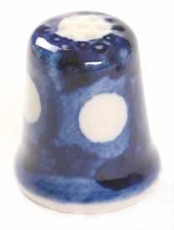
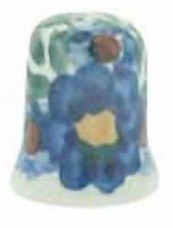

Fig 41 Fig 42 Fig 43
Conclusion
Most currently available East European thimbles seem to be of the ceramic or porcelain kind and are inexpensive to buy. We have failed to identify any old thimbles from Eastern Europe with the exception of Estonia and Latvia and this is very difficult to explain. We would welcome notification of thimbles from any East European county in order to augment the record as very little seems to have been written about these thimbles to date.
We would like to thank Mr. Wolf-Dieter Scholz for his help in finding the individual thimble makers and Mr. Ray Nimmo for the pictures of the etui.
References
1. von Hoelle JJ. Thimble collector’s encyclopedia. Illinois: Wallace-Homestead Book Company, 1986. pp. 134.
2. Holmes EF. A history of thimbles. London: Cornwall Books, 1985. pp. 69.
3. Snodgrass G. Bohemian-Czechoslovakian China at
http://www.collectorscircle.com/bohemian/bohemian_china.html
4. Holmes E F. Thimble Notes and Queries, 1989; 4: 19.
5. Windsor J. Learn to play your cards right. The Independent, London October 15, 1995
6. Helsila I and Helsila M. Einige Notizen über russische Fingerhüte. Rund um den Fingerhut, 2000; 32: 15.
7 Groiss F. Thimble Faktory in Vienna founded 1863. Druckerei Gerstmayer Gesellschaft m.b.H., Vienna.
TCI Bulletin Winter 2010
Holmes: ‘Porcelain Thimbles’ pp. 73.
Researched and published in 2002/11
Copyright@2011. All Rights Reserved
Magdalena and William Isbister, Moosbach, Germany
eastern european thimbles
Navigation
